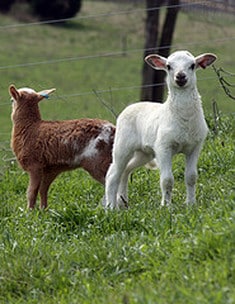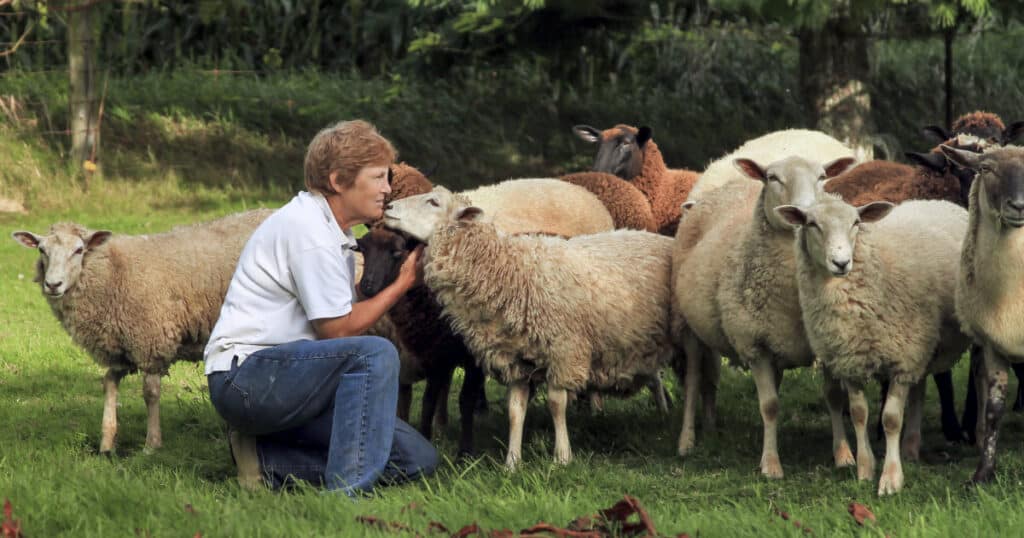All sheep are not alike and deciding on the type of sheep you want to raise is a big choice. There are literally dozens of breeds of sheep to choose from when choosing a breed for your farm. In this article I’ll share some of the best sheep breeds for beginners. I’ll also provide an overview of the different types of sheep that are available, so you can make an informed choice.
But, first thing’s first. As you decide which breed is right for your operation, there is one question you should ask. This is: Why am I Raising Sheep?
That may seem like a strange question, but every type of sheep can serve a different purpose on your farm. Some breeds produce excellent wool, some are big, rapid-gainers that are great for meat production. Each breed is different, so exploring why you want to have sheep will help guide you to the right breed.
Best Sheep Breeds for Beginners (my picks)
We have an expansive breed directory which can be a great place to start your research. But in case you’d like someone who has raised sheep for years to give you a nudge in the right direction, I’ve put together the following list.
The breeds below are what I consider to be the best breeds to own for different types of farmers getting started with sheep. These are the breeds I’d recommend to friends and family based on the type of sheep they want.
| Reason for Wanting Sheep | Best Breed for You |
|---|---|
| Young child joining 4H and planning to show for the first time. | Southdown – a small, cute breed that’s easy to handle and prepare for show. |
| Want sheep, but don’t want to bother with annual shearing. | Katahdin – this hair breed won’t require shearing, their meat is great, and they’re parasite resistant which will save you money. |
| New or aspiring fiber artist. | Romney – a docile, beautiful breed with lustrous fleece that’s perfect for hand-spinning. |
| Expert fiber artist / commercial wool production. | Merino – the gold standard for high quality wool for high-end garments. |
| Commercial meat production. | Texel or Suffolk – Either of these terminal sire breeds work great for commercial meat production. They’ll produce high-yield lambs that are ready for slaughter early. |
| Want to produce both quality meat and wool. | Corriedale or Columbia – Each of these dual-purpose breeds are attractive, hardy, and productive as a meat and a wool breed. Choose whichever is available in your area. |
| Want sheep for a pet / hobby farm. | Jacob – A unique black and white wool coat with unique horns (up to 4), Jacob sheep are striking to look at, easy to handle, and will add interest to your farm. |
Digging Deeper: Exploring More Options
Let’s dig a little deeper and explore the different breed types available to you. Each of these sheep “categories” is filled with a variety of breeds that excel at their given production role.

We’ll cover most of them here:
Long Wool Sheep Breeds
Breeds with long wool, such as the Romney, Border Leicester, Lincoln, and others are popular with beginners interested in hand-spinning and fiber arts.
These breeds produce long, lustrous fibers which are highly valued by craftsmen and craftswomen. Hand-spinners and those interested in knitting and felting custom items adore these breeds.
Many of these breeds are known for their hardiness, for being prolific and for their strong maternal instinct. In my experience, they tend to be slightly more docile than larger breeds as well.
Meat Sheep Breeds
Sheep breeds raised for meat production are valued for their rapid weight gain, hardiness, and the lean, well-muscled carcass they produce.
Some meat breeds such as the Southdown, Suffolk and Hampshire produce wool as well. But their wool isn’t as highly valued as those produced by wool breeds. They also don’t produce as much wool each year.
I think these breeds are an excellent choice for beginners with youngsters interested in showing sheep at their local fair. The Southdown in particular is a great breed for young children, as they’re small, cute, and easy to prepare for show.
Other sheep commonly raised for meat are hair sheep – so named because they shed what woolly fibers they have (if any); fibers that are of no value. The value in these breeds, is in their carcass. These sheep breeds are less fatty, milder tasting and have higher protein/lower cholesterol meat than wool sheep breeds.
The Katahdin, St. Croix, Barbados and Dorper are the most popular breeds of hair sheep raised for meat. The Katahdin is a hardy, easy-lambing animal that produces a quality carcass. The Dorper, though a bit fattier if not processed early, is also a good meat breed choice. The Barbados Blackbelly, however, are thinner and not nearly as docile.
Fine Wool Breeds
Breeds raised for their dense, fine-crimp wool such as the Merino, Rambouillet, and Debouillet are renowned for their ability to produce high quality wool which is sought after for the construction of high-end clothing. This is in large part due to the softness of the fibers thanks to a tight, high crimp (waviness) fleece.
These sheep tend to look dirty on the farm because their superior wool is packed with lanolin (the natural grease in wool) which attracts dirt and dust like a magnet.
Dual Purpose Breeds of Sheep
Sheep breeds like the Columbia, Corriedale or the Polypay offer sheep breeders the opportunity to raise sheep with valuable wool and valuable meat production abilities.
In my opinion, these breeds are some of the best sheep breeds for beginners because they allow you to do a little bit of everything and discover what you like most. They’re typically hardy, resilient, and easy to manage if you choose a smaller breed in this category.
Rare, Minor, and Heritage Breeds of Sheep
Breeds in this category, such as the Icelandic, Jacob and others are more rare and they are often raised for their appearance as much as anything else. Many people who don’t care about the show ring, and may not be looking to own sheep for wool or meat production (preferring beautiful sheep to populate their farm) will be attracted to these unique and wonderful breeds.
These sheep tend to be more docile than many larger breeds.
Why People Choose to Raise Sheep in the US

These days most people who raise sheep commercially in the US do so to sell lambs for meat. The rise in popularity of eating lamb is due to the increased ethnic populations in the United States. There has also been improved awareness of the health benefits and tastiness of lamb.
The production of wool remains a strong industry, although it is not nearly as strong as it was during WWII. It often takes several years for wool production to be even slightly profitable for sheep producers as it generally will take more time to establish a market for your wool and wool products and because it takes a year to produce a fleece whereas lambs can be ready for market within a few months. For most smaller hobby wool farmers it often costs more to get the sheep shorn than they can charge for the wool their sheep produce.
The other reasons you might find to raise sheep include…
- Raising sheep for the purpose of harvesting their wool for spinning and dying to make specialty yarns is popular among craftsmen.
- Those who make lotions and soaps out of all-natural ingredients use the lanolin and sheep milk for doing so.
- Hunting and game ranches often raise horned sheep. The curled horns are attractive to some hunters.
So…do your homework. Know which sheep breeds are best suited for your farm, family and your intended purpose. Our list of sheep breeds is a great resource as you research and will offer facts and insight as you make your decision.

